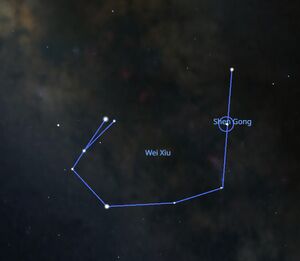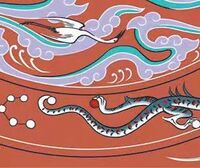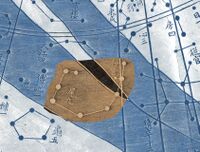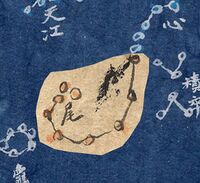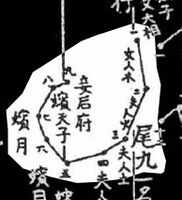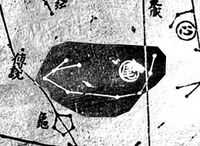Wěi (尾)
Wěi (尾, “Tail”) is the sixth of the 28 mansions/lodges, representing the tail of the Azure Dragon, the first of the Four Symbols of the Chinese sky. It is among the most ancient constellations in the Chinese celestial tradition and consists of nine stars corresponding to those of modern Scorpius.
Concordance, Etymology, History
The history of Wei as a constellation can be traced back at least to the seventh century BCE. In the Zuo zhuan ( Zuo Tradition), the section“Fifth Year of Duke Xi (僖公五年),” it is said: “(Before the army attacked the kindom Guo) A children's rhyme goes, ‘On the dawn of the bing day, the dragon’s tail is invisible while the Sun conjuncts with Moon. The ranks are all arrayed; seize the banner of Guo…’” (丙之晨,龙尾伏辰。均服振振,取虢之旗). Here, “dragon's tail” refers explicitly to the lodge Wei. The complete sequence of the 28 lodges is inscribed, on the lacquered box unearthed from the tomb of Marquis Yi of Zeng (early Warring States period, 5th century BCE), naturally including Wei.
From the Han dynasty onward, Wei acquired a rich variety of astrological interpretations. In the Tianguan shu (Book of Heaven Officials) of Sima Qian, it is described as “the Nine Sons of Heaven” or “the ruler and his ministers.” The Shishi xingjing (Master Shi’s Star Canon) records numerous alternate names such as Tiance (Heavenly Latrine), Tiangou (Heavenly Dog), and Tia ji (Heavenly Rooster), which likely originated from regional astrological schools or popular naming traditions. However, its most widespread interpretation associated the nine stars with the consorts of the emperor’s inner palace: the first star represented the Empress, while the remaining stars corresponded to the furen (secondary consorts), pin (concubines), and qie (lesser consorts). It was probably on the basis of this symbolic meaning that a new asterism, the Shengong (神宫) (Divine Palace), came into being.
The Shengong was conceived as the “inner chamber where the Emperor and his consort disrobe and find pleasure,” the only domain in this solemn astral empire that alludes to intimacy. It bore variant names such as Tianshi (Heavenly Excrement) and Tianjiujiang(Heavenly Nine Rivers); the former evidently relates to Heavenly Latrine, one of Wei's alternate names, possibly reflecting a common cultural source. The Divine Palace was not recorded in any official astronomical compilations before the eighth century, and it likely existed as an unofficial constellation. By the early 8th centuries CE, however, it had been incorporated into Wei as an auxiliary asterism.
The Indian-born imperial astronomer Gautama Siddha (fl. early 8th century), serving at the Tang (618 – 907 CE) court, wrote in the Kaiyuan zhanjing (Divination Canon of Kaiyuan Reign, KYZJ, compiles between 712–718 CE) that the officially used star charts and canons did not include this star, but that he had seen it mentioned in a text entitled Gu jing zan (“Annotation of Ancient (Star) Canons”). He thus adopted it into the official celestial system. [1]According to the record, this star lies beside the determinative star of Wei, at a distance of one cun (about 0.1 degree). Such a small value was almost certainly not derived from direct measurement, yet it shows that the star lies very close to the determinative star μ¹ Scorpii, clearly identifying it with μ² Scorpii, though its identification might change in later periods.
Identification of stars
The nine stars forming the principal body of Wei have remained unchanged for more than two millennia, and all researchers are in complete agreement regarding their identification.
| Star Names or Orders(Qing) | Indexes |
|---|---|
| 1st/Determinative Star/Hou(Empress) | mu1 Sco |
| 2nd/Furen | epsilon Sco |
| 3rd/Furen | zeta2 Sco |
| 4th/Furen | eta Sco |
| 5th/Pin | sigma Sco |
| 6th/Pin | iota1 Sco |
| 7th/Pin | kappa Sco |
| 8th/Pin | lambda Sco |
| 9th/Qie | mu Sco |
Maps (Gallery)
The earliest visual representation of this constellation appears in the mural of the 28 lodges discovered in a Western Han tomb at Xi'an Jiaotong University. However, this depiction uses only one star at the end of the Dragon's tail representing Wei, which clearly reflects an artisan's pictorial convention rather than an astronomer's chart. In contrast, in the Eastern Han mural star map unearthed from a tomb at Jingbian, Shaanxi, Wei and the dragon's tail are closely joined, and all nine stars are shown in full.
Among the earliest realistic star charts—those from the Tang dynasty or earlier, including the Cheonsang Yeolcha Bunyajido, the Dunhuang Star Map, and the Geziyuejintu—Wei is depicted with relative accuracy, though the precision varies among them. Most notable is the Suzhou Star Map, which, unlike other ancient star maps, renders Wei with greater east–west breadth—an intentional adjustment accounting for the projection distortion near the invisible circle in circular star maps.
- Wei
Star Name Discussion (IAU)
In 202x, the name of the historical constellation "xxx" was suggested to be used for one of the stars in this constellation. ...
Decision: ...
References
- ↑ Qutan Xida, Kaiyuanzhanjing 开元占经. (Beijing: Jiuzhou Press, 2012), 579,1035.
